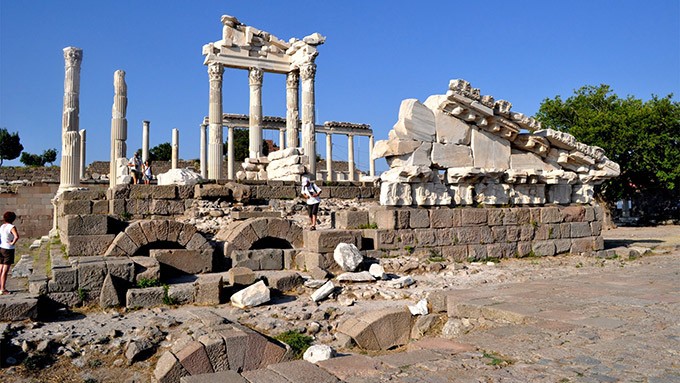
Pergamon, an ancient Greek city strategically positioned near the Caicus River, is 26 kilometers away from the Aegean Sea and 85 kilometers from Izmir. During the Hellenistic period, it emerged as the capital of the Kingdom of Pergamon. The city’s history took a significant turn in 281 BC when Philataerus, an officer and successor of Alexander the Great, seized control after Lysimachus’s defeat by Seleucus of Syria. Philataerus’s nephew, Eumenes, later declared Pergamon’s independence, marking the beginning of a period of prosperity and alliance with the Roman Empire against Philip V of Macedonia.
The rulers of Pergamon, starting with Philataerus and his successors, embarked on ambitious development projects. They constructed magnificent temples, extensive road networks, and a library that rivaled the famous Library of Alexandria in Egypt. Additionally, the Asclepion was established, becoming a renowned center for medical education, healing, and spa treatments.
The Attalid dynasty’s support extended beyond the city’s borders, aiding the growth of neighboring towns by dispatching skilled artisans and offering tax exemptions. They also made generous contributions to cultural sites across Greece, including Delphi, Delos, and Athens. Pergamon’s wealth primarily derived from its agricultural output and the exploitation of silver mines. The construction of numerous temples dedicated to Athena showcased the city’s prosperity, which eventually raised concerns with Rome.
In 133 BC, Attalus III, the last of the Attalid rulers, died without an heir and bequeathed his kingdom to Rome. Initially, Rome hesitated to take over Pergamon. However, Aristonicus, who claimed to be the son of Eumenes II, led a revolt of the poor against Roman control. Despite Aristonicus’s valiant efforts and Pergamon momentarily regaining its freedom, the city never fully escaped Roman influence after Attalus III’s demise.
Pergamon’s distinct Hellenistic culture exerted a strong influence on Rome, which sought to emulate its achievements. Eventually, the city became a pivotal center for the Imperial Cult in the East, celebrating the worship of Zeus and Asclepius. In 29 BC, Augustus sanctioned the construction of a grand temple dedicated to Zeus, whose remains have been relocated to the Pergamon Museum in Berlin.
Under the reigns of Hadrian and Trajan, Pergamon was adorned with renovated temples, further enhancing its status as a prosperous and beautiful city.
As one of the Seven Churches of Revelation, Pergamon was labeled as the dwelling place of Satan and the site of his throne, likely referring to the Altar of Zeus.
Today, the remnants of Pergamon offer a glimpse into its rich past. The Upper Acropolis features a Hellenistic Theater, the Sanctuary of Trajan, the Sanctuary of Athena, the Library (Athenaeum), Royal Palaces, the Heroon (a shrine dedicated to the kings of Pergamon), the Temple of Dionysus, the Upper Agora, Roman Baths, the Diodorus Pasporos Heroon, and Arsenals. The Library of Pergamon, second in renown only to Alexandria’s, housed over 200,000 books and is rumored to have been gifted by Marc Anthony to Cleopatra as a wedding present.
The Lower Acropolis is home to the Upper Gymnasium, Middle Gymnasium, Lower Gymnasium, the Temple of Demeter, the Sanctuary of Hera, the House of Attalus, the Lower Agora, and the Gate of Eumenes.
At the base of the acropolis lies the Asclepion, or sanctuary of Asclepius, the god of healing. An 820-meter-long colonnaded sacred way led visitors to this spa and medical center, where treatments involved sacred waters, music, and dream interpretation, believed to reveal healing visions from Asclepius himself. The site includes a Roman Theater, the North Stoa, the South Stoa, the Temple of Asclepius, a circular treatment center, a healing spring, an underground passageway, a library, the Via Tecta (the sacred way), and a Propylon.
The Serapis Temple, initially dedicated to the Egyptian deities and later known as the Red Basilica, was converted into a Christian church in the 1st century AD. This structure, part of the seven churches mentioned in the Book of Revelations, further cements Pergamon’s place in religious history.



